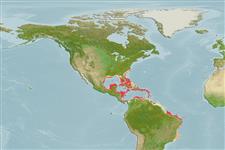>
Ovalentaria/misc (Various families in series Ovalentaria) >
Opistognathidae (Jawfishes)
Etymology: Opistognathus: Greek, opisthe = behind + Greek, gnathos = jaw (Ref. 45335); to the very elongate upper jaw of the type species of the genus, Opistognathus nigromarginatus (Ref. 128653).
More on authors: Jordan & Thompson.
Environment: milieu / climate zone / depth range / distribution range
Écologie
marin récifal; profondeur 3 - 40 m (Ref. 9710), usually 3 - 40 m (Ref. 27115). Tropical; 22°C - 28°C (Ref. 27115); 32°N - 23°S, 100°W - 29°W
Western Central Atlantic: southern Florida, USA and Bahamas to Barbados and northern South America.
Taille / Poids / Âge
Maturity: Lm ? range ? - ? cm
Max length : 10.0 cm TL mâle / non sexé; (Ref. 7251)
Description synthétique
Morphologie | Morphométrie
Épines dorsales (Total): 11; Rayons mous dorsaux (Total): 15-16; Épines anales 3; Rayons mous anaux: 14 - 15. Body light bluish gray with numerous pale blue dots; head, nape and anterior part of dorsal fin yellow; a pair of black spots often present on chin (Ref. 13442).
Inhabit burrows made of crushed coral or sand. Hovers vertically, above or near its hole. The male courts the female by swimming in an arched position with his fins spread towards her (Ref. 9710). Male broods the eggs orally (Ref. 5521). Has been reared in captivity (Ref. 35427).
Life cycle and mating behavior
Maturité | Reproduction | Frai | Œufs | Fécondité | Larves
Mouthbrooders. Eggs which are clumped together in a sticky ball get incubated inside the male's mouth (Ref. 5521). Monogamous mating is observed irrespective of resource abundance (Ref. 52884).
Robins, C.R. and G.C. Ray, 1986. A field guide to Atlantic coast fishes of North America. Houghton Mifflin Company, Boston, U.S.A. 354 p. (Ref. 7251)
Statut dans la liste rouge de l'IUCN (Ref. 130435)
Menace pour l'homme
Harmless
Utilisations par l'homme
Aquarium: Commercial
Plus d'informations
Taille/ÂgeCroissanceLongueur-poidsLongueur-longueurFréquences de longueursMorphométrieMorphologieLarvesDynamique des populations larvairesRecrutementAbondanceBRUVS
RéférencesAquacultureProfil d'aquacultureSouchesGénétiqueElectrophoresesHéritabilitéPathologiesTraitementNutrientsMass conversion
CollaborateursImagesStamps, Coins Misc.SonsCiguateraVitesseType de nageSurface branchialeOtolithesCerveauxVision
Outils
Warning: mysqli::__construct(): (08004/1040): Too many connections in /var/www/html/includes/speciessummary.lib.php on line 2414
Can't connect to MySQL database fbquizv2. Errorcode: Too many connections
